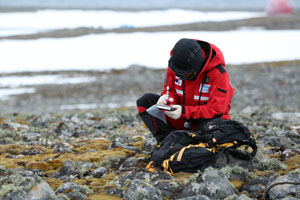
To evade the immune system, some viruses hide in cells of their host and persist there. In medical terminology, this state is referred to as a latent…
The dispersion and reaction of two immiscible liquids with subsequently separation of the products according to the state of the art need several steps. The invention enables process intensification, the dispersion, reaction and separation of two immiscible liquids in one device in one batch process. The core of the invention is a rotatable reactor with an integrated centrifuge. Thus the invention enables equipment reduction of separate mixing and separation devices. Depending on how the motors run towards another, a mixing or a centrifugal effect is produced. Competitive Advantages:
•Compact and cost effective
•Mixing and Separation in one device
•Complete control on measurements parameters
•Variable energy input
•Quantitative results
•Short contact times also with coalescence inhibited substance Systems
•No back-mixing
Current Status: A patent application for this invention has been filed in Germany. On behalf of the RWTH University, PROvendis is seeking a partner for further development in view of licensing the Technology.
The characterization of sedimentation and coalescence processes in a multi-phase system is a crucial step for the design and development of equipments for phase dispersion and separations. An established model of phase separator is based on the application of a gravitational field on the multiphase system. For those kinds of equipments, an early system characterization is possible thanks to suitable procedures and instruments established at laboratory-scale.
An effective alternative to gravitational separators are annular centrifugal contactors. Those equipments offer a better scalability and flexibility respect to the gravitational separator. Furthermore, they provide a versatile solution as phase separators as well as chemical reactors. Although centrifugal contactors are already established at the industrial level, a pre-characterization of the systems of interest in small equipment is not possible with the existing technologies. Competitive Advantages:
•Compact and cost effective
•Enables pre-characterization al lab level for processes in centrifugal contactors
•On-line camera
•Complete control on measurements parameters
•Quantitative results
Current Status: A patent application for this invention has been filed in Germany. On behalf of the RWTH University, PROvendis is seeking a partner for further development in view of licensing the technology.

In order to improve our understanding of the impact climate change has on plant life in the Antarctic, the Rector of the University of Freiburg/Germany, Prof….
Device and method of treating objects & bulk materials with a physical plasma cushion at atmospheric pressure. The plasma passes from the discharge chamber to the treatment chamber through a sparger plate comprising a multitude of holes, producing a plasma cushion, which supports & slides/pushes the objects while treating them.
Mechanical elasticity is a central parameter of living cells and tissues. Cancerous and healthy tissues, for example, have a different elasticity. Therefore, tools are under development to make tissue elasticity a new diagnostic marker in medicine1. Nevertheless, these efforts have been hampered by poor spatial resolution (i.e. ultrasound elastography) or by their usability being restricted to an in vitro environment (i.e. scanning ion conductance microscopy2,3,4 (SICM)).
Here, we present a novel instrument which transfers principles of SICM into the macro-environment of endoscopy or laparoscopy. This opens the door for a real-time measurement of tissue elasticity, e. g., during minimally invasive surgery.
Our handheld device uses the pressure of a water jet for inducing a deformation of the outer surface of any given tissue. The resulting change in a simultaneously recorded ion current between two electrodes on the “water nozzle” renders charac-teristic parameters for the elasticity of the tissue.